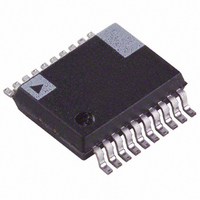AD607ARS Analog Devices Inc, AD607ARS Datasheet - Page 19

AD607ARS
Manufacturer Part Number
AD607ARS
Description
IC LIN RCVR IF SUBSYS LP 20-SSOP
Manufacturer
Analog Devices Inc
Datasheet
1.AD607-EBZ.pdf
(24 pages)
Specifications of AD607ARS
Rohs Status
RoHS non-compliant
Function
Receiver IF Subsystem
Frequency
500MHz
Rf Type
Cellular, GSM, CDMA, TDMA, TETRA
Secondary Attributes
-8dBm Input Third Order Intercept
Package / Case
20-SSOP (0.200", 5.30mm Width)
Operating Supply Voltage
3V
Operating Temperature (min)
-40C
Operating Temperature (max)
85C
Operating Temperature Classification
Industrial
Lead Free Status / Rohs Status
Not Compliant
Available stocks
Company
Part Number
Manufacturer
Quantity
Price
Company:
Part Number:
AD607ARS
Manufacturer:
AD
Quantity:
5 510
Company:
Part Number:
AD607ARS
Manufacturer:
NEC
Quantity:
5 510
Part Number:
AD607ARS
Manufacturer:
ADI/亚德诺
Quantity:
20 000
Company:
Part Number:
AD607ARSZ
Manufacturer:
ADI
Quantity:
730
Part Number:
AD607ARSZ
Manufacturer:
ADI/亚德诺
Quantity:
20 000
As noted earlier, the gain in dB is reduced linearly with the voltage
V
gains vary with V
a supply voltage of 3 V is used. Figure 24 shows how these vary
when GREF is connected to a 1.23 V reference.
Using the AD607 with a Fast PRUP Control Signal
If the AD607 is used in a system in which the PRUP signal
(Pin 3) is applied with a rise time less than 35 µs, anomalous
behavior occasionally occurs. The problem is intermittent, so it
will not occur every time the part is powered up under these
conditions. It does not occur for any other normal operating condi-
tions when the PRUP signal has a rise time slower than 35 µs.
Symptoms of operation with too fast a PRUP signal include low
gain, oscillations at the I or Q outputs of the device, or no valid
data occurring at the output of the AD607. The problem causes
no permanent damage to the AD607, so it will often operate
normally when reset.
REV. C
G
90dB
80dB
70dB
60dB
50dB
40dB
30dB
20dB
10dB
on the GAIN pin. Figure 23 shows how the mixer and IF strip
0dB
90dB
80dB
70dB
60dB
50dB
40dB
30dB
20dB
10dB
0dB
Figure 24. Gain Distribution for GREF = 1.23 V
0
Figure 23. Gain Distribution for GREF = 1.5 V
0
0.4V
0.328V
G
when GREF is connected to VMID (1.5 V) and
(67.5dB)
(21.5dB)
NORMAL OPERATING RANGE
NORMAL OPERATING RANGE
(21.5dB)
(67.5dB)
1V
MIXER GAIN
IF GAIN
MIXER GAIN
IF GAIN
1V
1.64V
1.8V
2V
(7.5dB)
V
G
2V
(1.5dB)
2.2V
(7.5dB)
V
G
(1.5dB)
–19–
Fortunately, there is a very simple solution to the fast PRUP
problem. If the PRUP signal (Pin 3) is slowed down so that
the rise time of the signal edge is greater than 35 µs, the
anomalous behavior will not occur. This can be realized by a
simple RC circuit connected to the PRUP pin, where R = 4.7 kΩ
and C = 1.5 nF. This circuit is shown in Figure 25.
All designs incorporating the AD607 should include this circuitry.
Note that connecting the PRUP pin to the supply voltage will
not eliminate the problem, since the supply voltage may have a
rise time faster than 35 µs. With this configuration, the 4.7 kΩ
series R and 1.5 nF shunt C should be placed between the
supply and the PRUP pin as shown in Figure 25.
AD607 EVALUATION BOARD
The AD607 evaluation board (Figures 26 and 27) consists of an
AD607, ground plane, I/O connectors, and a 10.7 MHz band-
pass filter. The RF and LO ports are terminated in 50 Ω to
provide a broadband match to external signal generators to
allow a choice of RF and LO input frequencies. The IF filter is
at 10.7 MHz and has 330 Ω input and output terminations; the
board is laid out to allow the user to substitute other filters for
other IFs.
The board provides SMA connectors for the RF and LO port
inputs, the demodulated I and Q outputs, the manual gain con-
trol (MGC) input, the PLL input, and the power-up input. In
addition, the IF output is also available at an SMA connector;
this may be connected to the PLL input for carrier recovery to
realize synchronous AM and FM detection via the I and Q
demodulators, respectively. Table III lists the AD607 Evalua-
tion Board’s I/O Connectors and their functions.
Figure 25. Proper Configuration of AD607 PRUP Signal
CONTROL SIGNAL
FROM PRUP
4.7k
1.5nF
PRUP
AD607
AD607













